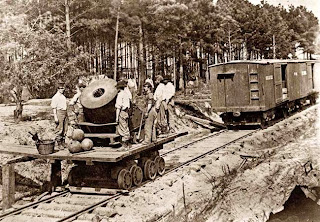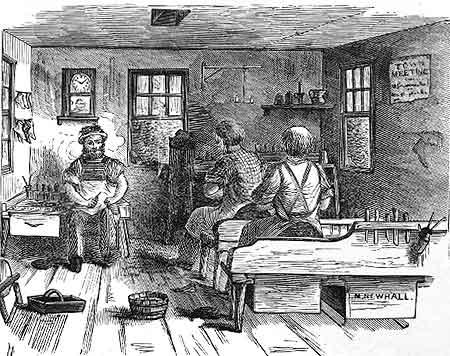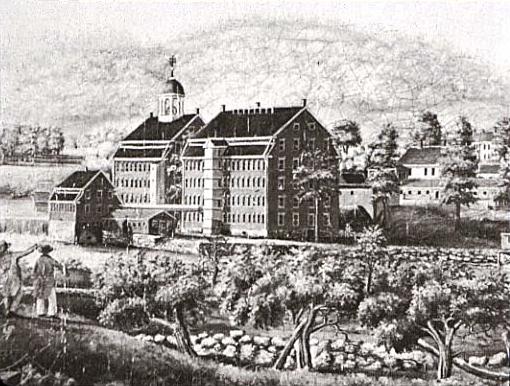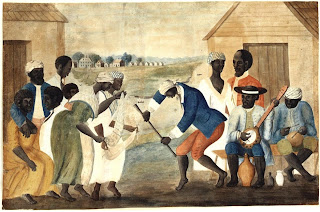To understand how work changed in the early history of the United States, it is necessary to have an understanding of how work was organized before there was a United States. We will examine how various Native American groups organized work, and then contrast that with how Europeans organized work during the same period. This will allow us to contrast the two, and give us some insights into the conflicts and misunderstanding the two societies had with each other.
Work in Native American Societies.
If you depend upon European accounts of how Native Americans worked at subsistence, you get the impression that natives lived off the largess of the land, and did little work--particularly males. Not surprisingly, this was really not the case. Natives did much to shape their environment, and at times before first contact with Europeans, had developed quite sophisticated
civilizations just as hierarchial as European societies; most famously this was the case with the Aztecs, but there were societies in North American that approached that level of sophistication, as well. Certainly the Moundbuilders of southern Ohio, Kentucky, Tennessee, and northern Alabama can be considered relatively sophisticated societies, and the artifacts those societies left behind (the mounds) are testament to both a hierachial society (that is to say, someone directed the work of building the mounds, and many people worked under that direction) as well the ability to produce a surplus of food to feed the workforce.

Cahokia Mounds, located just east of present-day St. Louis, is perhaps the apex of Native American civilization in North America. Cahokia was probably the largest city in North America until perhaps 1770, with a population conservatively estimated in excess of 14,000 people. This meant that there was, of course, a substantial popultion of workers building this huge complex of mounds to feed, build housing for, and keep warm. The downfall of Cahokia was probably due to the fact that all of this activity denuded the area of trees (for building activity and fuel to cook food), leaving the area susceptible to extreme flooding, which caused workers to lose confidence in the leaders of the society and to abandon the project. By the time of European contact, these complex societies in the middle of the continent has been largely abandoned. Maize cultivation continued, but native peoples (except those living in harsher climates like the American Southwest) largely returned to living in smaller, clan-based societies.

In these smaller, clan-based societies, much of the work of cultivation of food was done by the female members of the clan. The men usually assisted in preparing the fields (if preparation was deemed necessary), but most of the work was done by females. Men hunted game, and spent much of the rest of their time either hunting, at war with other native groups, or playing war-like games (lacrosse is the descendent of one of these games) with other native groups. While this seems patently unfair, this gave women tremendous influece over the affairs of the clan or group--because they provided most of the nutrition and sustenance for the group. In fact, most native peoples organized themselves along matrilineal lines (that is, they traced their descendence from their mother's family), and women often had a great deal of influence over the affairs of their clan. Cultivation of food in the "Indian style" was also less onerous, because of the way they cultivated food. Corn, beans, and squash--the "Three Sisters"--were all grown together in one mound. The corn stalk provided support for the beans, while the squash grew along the ground and inhibited the growth of weeds. Childcare was a shared responsibility among the women, as well.

Work in European Socities
We are quite familiar with the way work was organized in European Societies, because that has, of course, become the way that work is organized in most modern societies. During the early years of contact with Native American societies, however, work was organized in Europe very differently than work in an industrialized society. Before 1600, most workers were engaged in agricultural work. With the emergence of industry this means of organizing work changed drastically. The term "industrial revolution" is often used to describe these changes, but that term is something of a misnomer. These changes were gradual, taking years to take hold. This means that the changes so affected were not necessarily destined to happen, or irreversible. One of the earliest responses to these changes in England was the passage of the Statute of Artificers (1562). This law attempted to limit the maximum pay workers could obtain, and also limit the opportunities for advancement for these workers. The law also decreed that sons had to follow in the trade of their fathers.

This development was in part a response to the disruption the enclosure of the commons caused British society. The commons was essential to subsistence farming in Great Britain, because it allowed those without adequate land of their own to keep livestock--a goat, sheep, or perhaps even a cow. When country gentry began to enclose these areas, claiming "ownership," this began forcing poor farmers off the land and into cities, where they could only subsist by casual day labor, obtaining a trade, or shipping out to sea on either a merchant ship or man'o'war--particularly attractive with the Spanish discovery of gold in the New World and the willlingness of Queen Elizabeth to grant writs of marque for privateers. The wealth Spain was obtaining from the New World, and their alleged mistreatment of the natives, led other countries--including Great Britain--to claim rights to obtain land in North America.
Jamestown
The Virginia Company were a group of investors, expecting a return on their investment, on the model of the West Indies Company that had financed the sugar plantations in the British Caribbean.
 Captain John Smith was a much more complex character than Disney would lead you to believe; short, swarthy, and hairy (by contemporary accounts); Smith proposed to overcome the natives militarily and then enslave them, using the Spanish model. The Jamestown settlement was reliant upon Smith’s ability to cajole and threaten to get corn from the natives; the natives soon realize this and threaten to abandon the area and allow whites to stave to death.
Captain John Smith was a much more complex character than Disney would lead you to believe; short, swarthy, and hairy (by contemporary accounts); Smith proposed to overcome the natives militarily and then enslave them, using the Spanish model. The Jamestown settlement was reliant upon Smith’s ability to cajole and threaten to get corn from the natives; the natives soon realize this and threaten to abandon the area and allow whites to stave to death.
“The Starving Time” (1607) – then inability of the Jamestown settlement to grow enough food for themselves, combined with the diseases they contracted which incapacitated a number of them, meant that for the first several years the people of the settlement were reliant upon food arriving for them from England. When shipments were delayed or did not arrive, a number of settlers quietly starved to death. Smith’s leadership ameliorated this condition somewhat, since he decreed and enforced that all settlers were to put in 4-6 hours a day in the fields (or they would not eat). The Virginia Company had no idea what it would take to set up a productive colony in North America; they sent workers like goldsmith and jewelers, whose crafts provided a newly established settlement with no useful skills, and would not for a number of years; the people sent to Jamestown were also top-heavy with gentlemen, who did no manual labor by station, and not enough husbandmen and farmers.
The settlers at Jamestown were completely dependent upon natives supplying them with food – but the relations with the natives were strained; battles with natives broke out in which military operations were carried out which would burn villages and destroy caches of the corn crop—which the English themselves were dependent upon. The condition of the settlers compelled some to commit acts of cannibalism; in a recorded instance, a man killed his wife, chopped her up and ate her, in an area of abundant game, fish, fruits, nuts, and berries. There were also instances of the dead being dug up so that the living could eat them.
Part of the reason for this was the social composition of Jamestown settlers:
1) Gentlemen – 36 of 105 settlers, which meant that nearly 1/3 of settlers, expected that they would perform no manual labor because it was beneath their station in life.
2) Craftsmen – made up the largest portion of the population, but none expected to work outside of their area of training, or outside of their craft (due to restrictions that they had always practiced that craft under—namely, the Statute of Artificers. Too often, their particular craft was not needed, so they sat around pursuing leisure activities (gambling, etc.) while they and their fellows starved to death.
3) Husbandmen and farmers – made up the smallest portion of the settlers, but they were expected to produce enough food for the entire settlement.
This organization of society seems senseless to us today—after all, if one were starving, why would you just accept that fate and not try to find food for yourself? But many English were use to an inadequate diet and hunger while they were in England, and they had no expectation that life would be substantially different for them on a new continent.

The Tobacco Boom (1611-1630, approximately) – the best grade of tobacco came to Europe from Turkey; Virginia tobacco was considered a grade or two below that, but tobacco was destined to provide the colony with a way to attract new investment. At first, tobacco was seen as undesirable, an unclean habit; it increasingly gained favor, however, with a resultant rise in the value of tobacco. The addictive nature of tobacco, and the newly abundant supply, created a price boom – by 1619, the price a tobacco farmer could get for tobacco was approximately three shillings a pound (or approximately $1,500/hogshead barrel, which equaled about 300lbs.). This price only prevailed for about ten years, however; as the market was flooded with Chesapeake tobacco, the price declined, until in 1630 the price for a pound of tobacco had declined to about a penny a pound (or $5.00/hogshead). The immediate effect, however, was to create a labor shortage – to take advantage of this tobacco boom, tobacco growers needed to get labor to the colony to produce the crop to sell to merchants in England.
Tobacco is a labor-intensive crop; the growing, harvesting, and processing of tobacco required a great deal of labor. On top of this, it takes a year and a half for the tobacco plant to mature, and the plant needs a lot of attention to flourish. One person could attend to approximately 2,000 tobacco plants, which in turn would yield about 500lbs of tobacco; therefore, the more labor one could employ (but not necessarily in the definition of pay), the greater one’s chances of making a substantial amount of money there were. This coincided with a labor “surplus” in England, which during this time was undergoing a period of consolidation of land holdings on the part of the landed gentry (the enclosure of the commons), and the early beginnings of the Industrial Revolution (where peasants who where being pushed out of farming were in the process of becoming wage workers in factories in urban areas).

Labor “recruitment” came from prisons and workhouses, as well as those recruits of “spirits” and “crimps” who simply kidnapped persons of the lower classes, and put them on ships to the Americas to be employed as indentured servants (a practice which was known among this population as being “barbadosed,” because Barbados was the destination of the greatest share of such people, to work on the sugar plantations). Workers often required "seasoning” – ships with new indentured servants usually arrived in Virginia at the beginning of summer. The combination of a long, arduous journey, general malnutrition, and a variety of diseases then prevalent during the summer in the Chesapeake area (like malaria, typhus, and diphtheria), combined with the pace of work killed off a horrific number of workers.
Massacre of 1622
A surprise attack by natives upon Jamestown resulted in the killing of 347 men, women, and children; this resulted in a retaliatory strike by the remaining Jamestown settlers, and a determination to wipe out natives in the area once and for all; however, its also prompted an investigation by Parliament which uncovered the fact that despite the immigration of 3,570 people in the three years proceeding the native attack, only 1,240 English subjects were alive at the time of the attack. The population of Jamestown before this period of intensive immigration was 700—which meant that 3,030 people had died in the preceding three year time period. On top of this, the Virginia Company was nearly bankrupt; in 1624 the crown took over responsibility for the settlements in Virginia. The population losses decrease after this, but remained relatively high throughout the 1620s and 1630s.
Population increase from about 1640, due in part to the drop in demand for tobacco (the market was glutted at this time period); other crops with less intensive labor requirementswere grown which were then sold to plantations in the Caribbean. The propagation of apple trees – used largely to make cider, which meant that less contaminated water was consumed, which decreased the prevalence of diseases like dysentery and typhus); new workers began arriving in the fall, rather than new workers arriving in the beginning of summer, they arrived at the beginning of fall, which gave them a longer time to acclimate themselves.
New Problems
This led to an increased demand for land, as more servants survived their period of indenture, there was a corresponding increase in the demand for more land. Indentured servants, by contract, were given head rights – the term used to explain the right to land that one claimed when it could be proven that one making such a claim had paid for the passage of another to the colony (this helped provide a larger number of planters to employ indentured servants, who themselves were usually promised a substantial amount of land and the tools to work it in return for their labor); because unimproved land was more valuable than improved land (tobacco could only be grown for a three or four year period before exhausting the land), those who could afford to employ indentured servants benefit. This led to increased costs of labor, as more indentured servants survived their period of service and made greater demands for land. When indentured servants did not survive the seven years of their service, it was more economically viable for large planters to employ indentured servants; as these indentured servants began to live longer, however, the employment of slaves became more attractive. The higher initial cost of slavery – the employment of slaves had a higher start-up cost, because slaves were more expensive than indentured servants--meant that until one could amortize this cost over the productive life of the slave, the cost ended up being less than that for indentured servants.



































